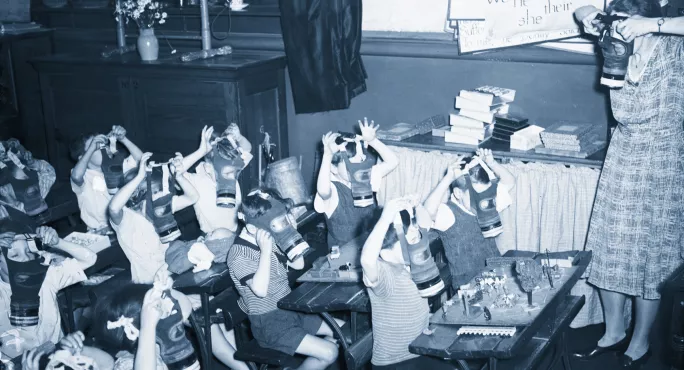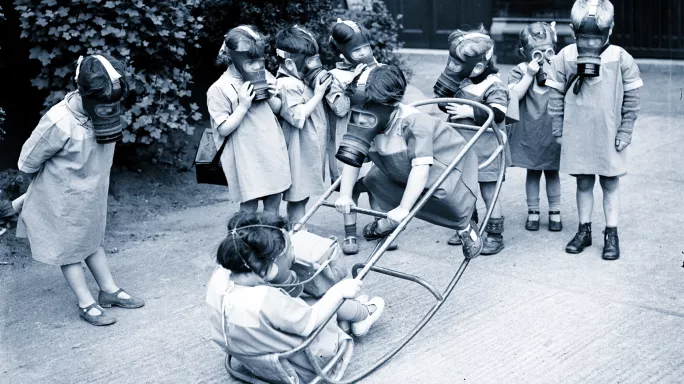- Home
- Why pupils won’t wear face masks: a lesson from history
Why pupils won’t wear face masks: a lesson from history

The start of the 1939 school year was overshadowed by the outbreak of the Second World War. With the new year, came new school rules: gas masks must be carried at all times.
In preparation for war, the Air Raid Precautions authorities distributed tens of millions of respirators. In the shadow of the poison-gas threat, one challenge remained: to convince children as young as 4 to carry and wear the masks that could save their lives.
As we mark the 75th anniversary of the Second World War, the issue of masks and personal protection in schools is making headlines again. What lessons can Home Front Britain offer to schools facing the challenges of a coronavirus pandemic?
Face masks in schools?
The imagined terrors of gas warfare in the 1930s were more akin to Cold War nuclear paranoia than the very real impact of Covid-19.
But the wheezing, coughing survivors of Great War gas attacks were living reminders of the horrors of chlorine and phosgene, while in Abyssinia Italian aircraft dropped gas bombs on African troops and civilians. In the science fiction of the time, the future war was an apocalypse of poison gas, with few survivors.
Against these terrors, how much protection could a two-shilling respirator really offer? Enough, the scientists suggested, to allow wearers to make their way to a gas-proof air-raid shelter with an airlock and filtration system.
The British government stockpiled tens of millions of general civilian respirators in adult and child sizes, as well as infant anti-gas helmets, and the colourful Mickey Mouse masks for toddlers.
Classrooms full of distraught and unidentifiable children
Providing an entire population with military-style protective equipment was unprecedented, and problems inevitably arose.
One problem with gas masks is that they are incredibly unpleasant to wear. The rubber face-piece clings to the skin, the filter gives a sensation of laboured breathing, the eye-piece quickly fogs over. You cannot eat or drink, speech is muffled, and there is an overwhelming smell of sweat and rubber.
In wartime propaganda photographs, British schoolchildren in gas masks played on swings, practised gymnastics and lined up patiently outside classrooms and air-raid shelters.

In reality, children hated them. Some tore them off after a few minutes. A few described overwhelming feelings of panic and claustrophobia. Others refused to wear them at all.
Many younger children cried hysterically, and some had to be physically restrained. Teachers found themselves facing classrooms of distraught and unidentifiable children.
The children of wartime Britain soon discovered many different uses for their gas masks. They made surprisingly effective catapults, provided disguises for shoplifting and muggings, and made peeling onions or using the outhouse more bearable.
Masks in their cardboard cases were swung on their strings like conkers, kicked about like footballs, played like drums or whipped about like medieval flails. Most notably, the masks offered a rich repertoire of fart noises.
Immersed in tear gas
To work effectively, a gas mask must be carefully fitted and worn correctly. And how better to test your newly fitted mask and be reassured of its effectiveness than to be immersed in tear gas?
In their masks, children were herded into gas vans or specially constructed gas chambers, and exposed to chloroacetophenone gas. According to the training scheme, if the mask was correctly fitted, they would experience no ill-effects. If there was any sensation of burning, the mask could be adjusted to fit better.
In practice, many training instructors decided to expose the children in their care to the corrosive gas, to teach them the importance of wearing their masks. Some pulled up the sides of the children’s masks, while others pulled their entire masks off.
Children described burning sensations in their eyes, nose and mouth that lasted for hours, while a few suffered chemical burns. Today, chloroacetophenone is no longer used as a tear gas, because of its toxicity.
There is little evidence to suggest that the tear-gassed children returned to their classrooms chastened and with a greater respect for their respirators.
Doomed policy
As the war progressed, the threat of gas attack receded, and teachers lost their zeal for gas drills. Some children simply left their gas masks at home, and used the empty cases to hide snacks, toys, pet frogs, comics, collections of shrapne, and other childhood treasures. At the war’s end, many of the hated gas masks ended up on VE-day bonfires.
There are no just-so lessons from history, but the failed brutalities of wartime gas-mask training suggest that teaching young children the life-saving importance of masks will be neither easy nor swift.
Good public health policy is grounded in responding to actual human behaviour, rather than naive ideals or computer simulations. Any response to Covid-19 in schools that relies on young children wearing masks diligently and properly is most likely doomed.
Today, the child’s gas mask is a disturbing, enduring, iconic image. For Banksy, children in Second World War respirators represent the victims of pollution.
In the famous “petrol bomber” mural in Derry, the boy with the Molotov cocktail is protected and disguised by his gas mask. In a memorably terrifying episode of Doctor Who, the little boy in the gas mask may not be a little boy at all.
Will the afterlives of the Covid-19 cloth masks be as rich, as strange and as long-lasting?
Dr Gabriel Moshenska is associate professor in public archaeology at the UCL Institute of Archaeology
Register with Tes and you can read two free articles every month plus you'll have access to our range of award-winning newsletters.
Keep reading with our special offer!
You’ve reached your limit of free articles this month.
- Unlimited access to all Tes magazine content
- Save your favourite articles and gift them to your colleagues
- Exclusive subscriber-only stories
- Over 200,000 archived articles
- Unlimited access to all Tes magazine content
- Save your favourite articles and gift them to your colleagues
- Exclusive subscriber-only stories
- Over 200,000 archived articles